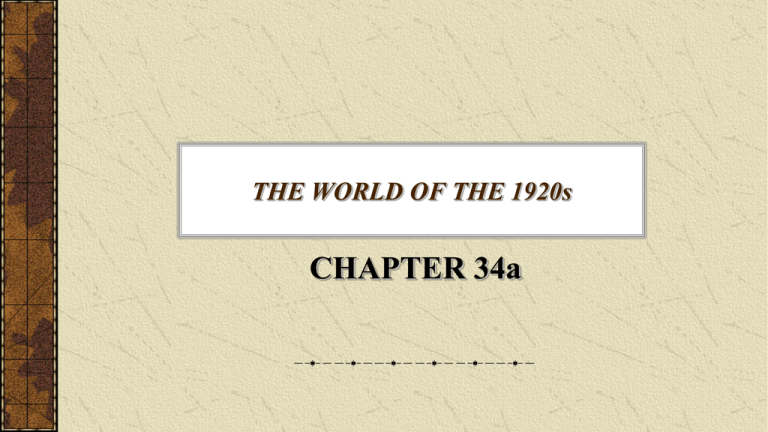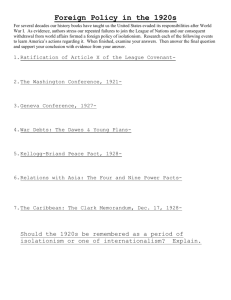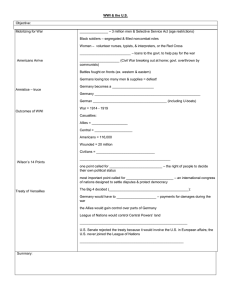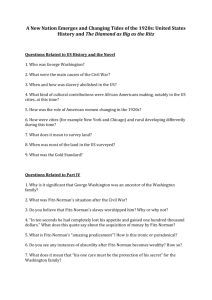CHAPTER 34a THE WORLD OF THE 1920s
advertisement

THE WORLD OF THE 1920s CHAPTER 34a THE ROARING 20s Period of apparent peace in early 1920s – Reduced internal political tensions in Europe – Extremist groups on the right and left • Appeared in the aftermath of World War I • Seemed to lose popularity by middle years of decade Industrialization and Consumerism – – – – – – Boomed on back of growing consumer demand Development of assembly line factories Wages increased purchasing power Power of middle class, middle class values rose Facilitated rise of consumerism Age of technological marvels: radio, airplane, auto Cultural creativity during the 1920s – Resulted in new artistic styles • These often conveyed some of the tensions of modern life • Art: Dadaism, Surrealism, Bauhaus, Cubism • Literature dealt with realism, often pessimism – Important new scientific discoveries appeared Gender Issues – Women across Europe, United States gained right to vote – Suffrage brought other social liberties. LEAGUE OF NATIONS The League of Nations created to maintain world peace – – – – – – – Forty-two members, twenty-six of them outside Europe Dominated by UK, France League used to isolate Germany The league had no power to enforce its decisions League could make suggestions, impose sanctions Collective security depended on all major powers Powers Left Out • United States never joined • USSR ignored; colonies not included • Germany not invited for some time The mandate system – – – – United States opposed direct colonization Allies proposed system of trusteeships France, United Kingdom benefited most Created from German colonies, Ottoman territories in S.W. Asia Idealistic Attempts during the 1920s – Attempt to outlaw war led to Kellogg-Briand treaty: we won’t use war to resolve “disputes or conflicts” – Result: people stop calling their wars “wars” THE NEW NATIONS OF EASTERN EUROPE Eastern European nations – – – – Arose out of Versailles Treaty at end of World War I Created out of Germany, Austria, Russia – often by force Each state was a kaleidoscope of different ethnic groups Different legal systems, rail gauges State Building – – – – – – Tried to emulate Western Europe without wealth, stability Also had to build new nations almost from scratch All were hostile to Communist regime in the Soviet Union Bitter rivalries broke out over territorial disputes Little industry, mostly agrarian Few cities, small middle classes or intellectuals Authoritarian Temptation – – – – – Parliamentary democracy damaged by competing parties Often major parties could not form a majority, rule by coalition Unable to solve social problems such as land reform, ethnic strife Most reverted to authoritarian or monarchical regimes Only Czechoslovakia remained a democracy throughout period RISE OF THE UNITED STATES World War I – – – – Put the United State into a position of leadership Became largest industrialized nation, largest center of banking Loaned Allies trillions Left war with 2nd largest navy in world, largest army Treaty of Versailles Rejected – – – Wilson and Republican Senate quarreled: Senate rejected treaty US refused to join League of Nation, retreats into Isolation Only in Latin America did USA remained actively interventionist The Red Scare – – 1919 – 1920s: US Government saw communists under every rock Ignored law and used CID (future FBI) to arrest communists (Palmer Raids) The Roaring 1920s – – U.S. leadership in world economic and cultural affairs accelerated New consumerism developed • • – U.S. corporations were innovators in technology and production techniques • • – Mass Production of appliances and automobiles Credit, Credit Cards, Catalogs Greatest mark came in popular culture • • • – American middle class became able to afford household luxuries Mass production reduced prices of most items: people began buying on credit Movies and Hollywood became world-wide symbols Rise of competitive, team sports and radio The Age of Jazz and American musicals by Gershwin were models for the world Many areas of economy like agriculture, banking very shaky with hidden problems JAPAN AND ITS EMPIRE Disappointments at Paris – – – Japan had wanted Germany’s Asian colonies During war decided to pick on China Allies had blocked Japan in its Chinese adventures Japan turned increasingly hostile – – Favored authoritarian government Began to plan for war, conquest in the interwar period An Economic Revolution led to many changes – – – – – – In early 20th century, agricultural and industrial production improved Great industrial combines (zaibatsus) launched expansion of heavy industry Government and industry cooperated Japanese standards of living began to improve By 1925, the state initiated compulsory primary-school education Japan relied heavily on import of raw materials, trade Problems for Japan Lead to Dictatorship – – – – Japan remained vulnerable to external economic conditions Population growth restricted advances in standards of living Social problems increased in crowded cities Military leaders took on a greater role in the 1920s • • • – They resented what they saw as the selfishness and pandering of the political parties Disliked democracy, liberalism as much as socialism, communism Hated reduction in military spending 1928: Tanaka Memorial – Japanese military draw up plans for Pacific War







